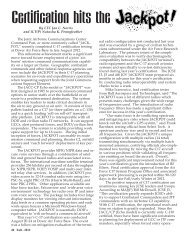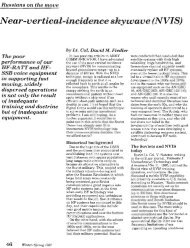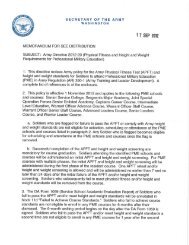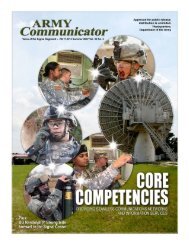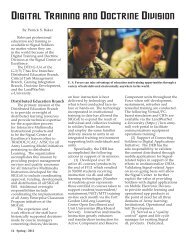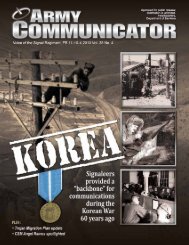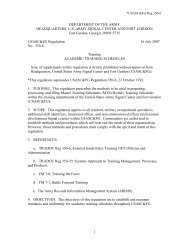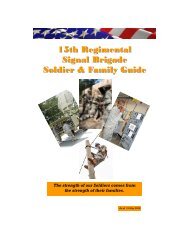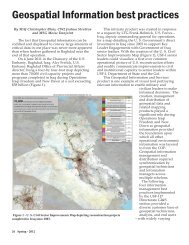AC Summer 08 WIN-T Online - United States Army Signal Center of ...
AC Summer 08 WIN-T Online - United States Army Signal Center of ...
AC Summer 08 WIN-T Online - United States Army Signal Center of ...
Create successful ePaper yourself
Turn your PDF publications into a flip-book with our unique Google optimized e-Paper software.
vision for tactical networks and<br />
communications and battle command<br />
platforms. Then you have<br />
really the working group levels that<br />
are underneath that. This is really<br />
where most <strong>of</strong> the work gets done.<br />
This is where the engineers take<br />
requirements from multiple programs<br />
and strategize to create a<br />
seamless integration <strong>of</strong> those programs<br />
and platforms into a single<br />
network. That is where you see a lot<br />
<strong>of</strong> the engineering work done, a lot<br />
<strong>of</strong> the lab testing done, a lot <strong>of</strong> white<br />
papers written and specifications<br />
that are written. All <strong>of</strong> those types<br />
<strong>of</strong> things are done at the third<br />
working group layer. The information<br />
flows up and down, so as we do<br />
things that the third tier layer, which<br />
is the current force working group,<br />
we bring that to tier 2. We work<br />
with the battle command folks, John<br />
Willison’s folks, we work with the<br />
(navigation) folks, Johnston<br />
Williamson, and the other folks and<br />
we start figuring out this is what we<br />
are bringing to the table. What can<br />
you change to work with us better,<br />
and what can we change to work<br />
with you better from a technical<br />
perspective?<br />
Sometimes those have programmatic<br />
impacts … So, it is going<br />
to continue to evolve in the IPT<br />
process because it keeps everybody<br />
in sync. If everybody just focused on<br />
their thing and didn’t look outside<br />
the box, then we may have programs<br />
that do not interoperate with one<br />
another and don’t communicate<br />
properly when they get to the field.<br />
By having the engineers work<br />
together in the IPT forum, now you<br />
are taking those engineers and<br />
you’re creating a forum for them to<br />
get together and share ideas on their<br />
programs and the things they are<br />
doing to help create a common<br />
vision for all <strong>of</strong> the programs, not<br />
just the one program. So, I think you<br />
will see it continue to evolve as we<br />
move forward.<br />
Josh Davidson: Will the Post-<br />
Deployment S<strong>of</strong>tware Support and<br />
Post-Production S<strong>of</strong>tware Support<br />
that the CECOM Life Cycle Management<br />
Command S<strong>of</strong>tware Engineer-<br />
ing <strong>Center</strong> provides continue with<br />
the future <strong>WIN</strong>-T increments?<br />
Jim Sintic: Absolutely. Engineering<br />
is only part <strong>of</strong> the battle.<br />
(There is) the sustainment piece, not<br />
just from a hardware perspective <strong>of</strong><br />
spare parts, logistics, and depots and<br />
things like that. Then, there is a<br />
s<strong>of</strong>tware aspect to it, because most <strong>of</strong><br />
the equipment we have is s<strong>of</strong>tware<br />
driven, even though it sits on a<br />
hardware platform. So, having<br />
someone like the SEC as a partner<br />
with the PM, like the Logistics and<br />
Readiness <strong>Center</strong> and some <strong>of</strong> the<br />
other organizations is critical to the<br />
successes because s<strong>of</strong>tware gets<br />
dated really fast.<br />
As you know, just working<br />
with the Directorate <strong>of</strong> Information<br />
Management with your computer,<br />
you need constant patches, upgrades,<br />
updates, security Information<br />
Assurance Vulnerability Alert<br />
patches, all need to be continuously<br />
updated and analyzed all the time.<br />
So, you need someone like the SEC<br />
to go through and evaluate as<br />
s<strong>of</strong>tware updates become available.<br />
They have to do the testing to make<br />
sure it is both forward and backward<br />
compatible, so that when they<br />
deploy the patches, it doesn’t break<br />
anything or affect anything you are<br />
supposed to do operationally.<br />
So, they are going to be a huge<br />
part (<strong>of</strong> our future efforts). Actually,<br />
more important than the actual<br />
engineering role, up front, only for<br />
the fact that the equipment is going<br />
to be there for so long. It is their<br />
responsibility to take that s<strong>of</strong>tware<br />
to the life cycle <strong>of</strong> the program. So, it<br />
is really important to have that.<br />
Josh Davidson: Can you<br />
explain in general terms how the<br />
components <strong>of</strong> <strong>WIN</strong>-T Increment 1<br />
connect to a satellite and maintain<br />
communications on the battlefield?<br />
Jim Sintic: Basically, if you<br />
look at the way we do things today,<br />
there are many different avenues for<br />
how we connect communications,<br />
especially from a satellite perspective.<br />
Right now, we use commercial<br />
satellite communications terminals,<br />
we connect to commercial satellite<br />
communications networks and we<br />
use Ku-band.<br />
In the future, we will migrate<br />
to Ka-band (from) a military operated<br />
satellite. The first one is supposed<br />
to be launched at the end <strong>of</strong><br />
this year. But, basically it’s a lot like<br />
the technology you use with your<br />
Direct TV or your Hughes.<br />
The big difference on the back<br />
end for us, is the fact that we have to<br />
make dishes that fit inside a different<br />
nomenclature for tactical use. (The<br />
dishes are) towed by Humvees and<br />
M1115 vehicles and things like that.<br />
And the biggest difference behind<br />
that is the fact that we use certain<br />
communications security material on<br />
the back end <strong>of</strong> those terminals,<br />
because everything that goes over<br />
the air is all encrypted. (This is)<br />
unlike your Hughes or your Direct<br />
TV, where it’s just commercial and<br />
everything is out in the clear, out in<br />
the open.<br />
Basically, we use the same<br />
technology in terms <strong>of</strong>: you have to<br />
know your latitude and longitude<br />
and <strong>of</strong> the different coordinates to<br />
align with the bird. We have<br />
spectrum analyzers inside the<br />
satellite communications transportable<br />
terminals to help do that; to<br />
align all the different satellite<br />
communications terminals. They all<br />
have to operate on different frequencies<br />
and things like that.<br />
Josh Davidson: What is the<br />
difference between the military and<br />
commercial satellite systems with<br />
regards to ruggedization?<br />
Jim Sintic: There is a big<br />
difference. When we build equipment<br />
here, and it’s not just satellite<br />
communications terminals but<br />
everything that we build, there are<br />
certain military specification regulations<br />
that we have to build equipment<br />
to. These give you all the<br />
environmental variables that you<br />
have to meet. You have to operate in<br />
certain conditions and the equipment<br />
has to be stored in certain<br />
conditions. It has to withstand wind,<br />
dust, electromagnetic interference,<br />
TEMPEST (Transient Electromag-<br />
<strong>Army</strong> Communicator 17



